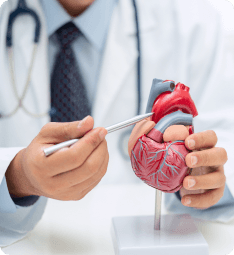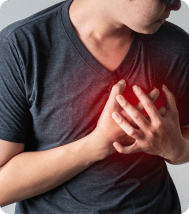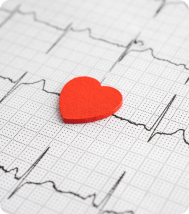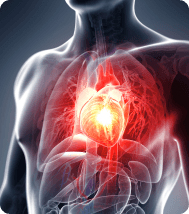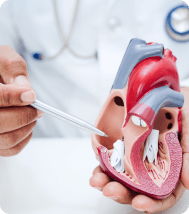Angina
What Is Angina?
Angina (angina pectoris or heart pain) occurs when there is insufficient oxygen-rich blood flowing through the heart muscles. It is often characterised by a tight feeling in a person’s chest, which may also extend up to the shoulders, arms, neck, jaw, or back.
Angina and a heart attack may present similar symptoms, like pressure, squeezing, or tightness in the chest. However, the pain from a heart attack is more intense, lasts longer and may be accompanied by additional symptoms such as shortness of breath, nausea, sweating, or pain radiating to the arm, neck, or jaw.
Angina is commonly due to an underlying heart problem such as Coronary Artery Disease (where the arteries supplying blood to the heart narrow and become blocked), which is the most common cause of heart disease and the main reason why people have heart attacks.


What Are the Symptoms of Angina?
One of the most common symptoms of angina is pain and discomfort in the chest, which tend to occur with physical activity or under stress.
Other symptoms include:
- Breathing difficulties
- Nausea or vomiting
- Abdominal pain
- Sweating
- Dizziness
- Fatigue
When experiencing any of the symptoms mentioned, it is crucial to seek medical attention immediately for appropriate angina treatment. These symptoms can be an indication of a more serious underlying cause.
As the symptoms can be quite common, a cardiologist should be consulted to determine if it is indeed a cardiac condition, an emergency, or something else. As a general rule, apart from heart pain, heart diseases also present with symptoms such as nausea, dizziness, fatigue and breathlessness – particularly in women.
What Causes Angina?
Most people develop angina due to coronary artery disease. As fatty deposits or plaque accumulate, an artery carrying blood through the heart becomes narrowed or blocked. This results in the onset of a disease known as atherosclerosis. Factors that may lead to this condition include:
Poor Nutrition
Diets high in saturated fats, cholesterol, and sugars can contribute to plaque buildup in the arteries, increasing the risk of atherosclerosis and angina.
Lack of Physical Activity
Sedentary lifestyles can lead to obesity and other risk factors such as high blood pressure and high cholesterol, which can cause arterial blockages.
Smoking
Smoking damages the lining of the arteries, promotes plaque buildup, and reduces oxygen in the blood, all of which can lead to angina.
Coronary Artery Spasms
These are sudden, temporary tightenings of the muscles within the artery walls, which can reduce or block blood flow to the heart, causing angina.
Diabetes
High blood sugar levels can damage the arteries and promote atherosclerosis, increasing the likelihood of experiencing angina.
Stress-Induced Physical Reactions
Stress can trigger the release of stress hormones like adrenaline, which increases heart rate and blood pressure. This can potentially lead to reduced blood flow to the heart and angina symptoms.
In Singapore, angina treatment is determined by the severity of the patient's condition. In mild cases, lifestyle changes, such as a balanced diet and exercise, may be helpful in managing symptoms. Medications and more invasive procedures are also possible methods of angina treatment in Singapore, which can help increase oxygen delivery to the heart and treat the underlying causes of the condition.
What Are the Types of Angina?
Stable Angina
With this, you constantly experience symptoms when your heart works harder than usual, such as while you are exercising. Unlike other types of angina, stable angina can be predicted and the pain only lasts a relatively short time. The discomfort can easily be relieved by resting or through angina treatment, including medication.
Unstable Angina
This is a medical emergency. This type of angina is unpredictable and may occur even when the body is at rest. It is more severe and can last up to 30 minutes or longer. Having an unstable angina might be a sign of an impending heart attack.
Variant Angina
This usually occurs when a person is at rest and often strikes around midnight and early in the morning. It can be very painful and is caused by a spasm in the coronary arteries, which is a result of either exposure to cold weather, medicine intake, smoking, or drug use.
Microvascular Angina
This may be a symptom of Coronary Microvascular Disease (MVD), a heart disease that affects the heart’s smallest coronary artery blood vessels.
It may be more severe and can last longer than other types of angina. It is also characterised by shortness of breath, sleep problems, fatigue, and lack of energy.
Am I at Risk of Angina?
- Family history of heart disease
- Obesity
- Lack of exercise
- Old age
- Diabetes
- High blood pressure
- High blood cholesterol or triglyceride levels
How Is Angina Diagnosed?
In order to differentiate angina from other non-heart-related causes of chest pain, several diagnostic tests may be performed:
Echocardiography
This test uses sound waves to examine the status of the heart. Results of echocardiography come in 2 and 3-dimensional images of the heart and it can show if blood is flowing properly in the chambers and valves of the heart.
Stress Test
Angina is easier to diagnose when the heart is working harder. During a stress test, the patient’s blood pressure and ECG readings are examined while he or she exercises by walking on a treadmill or pedalling a stationary bicycle.
Electrocardiogram
This procedure records a person’s heartbeat by using an electrical impulse generated from special cells. Through this, the doctor can look for patterns among the heartbeats to see if there is an abnormality in the blood flow through the vessels.
Chest X-ray
Images of the heart and lungs are taken with the help of this test. Chest X-rays can determine if there are existing structural abnormalities.
Coronary Angiography
This X-ray imaging test examines the inside of the heart’s blood vessels. During this procedure, a type of dye that is visible in an X-ray machine is injected into the heart’s blood vessels.
What Are the Treatments for Angina?
Angina treatment can involve oral medications. In more serious cases, an angioplasty or bypass surgery may be required to unblock the arteries and resume normal blood flow.
Medications
- Anticoagulants or Antiplatelet Drugs – These medications help lower the risk of blood clots that can block arteries and cause angina.
- Blood Pressure Medications – Medicines like beta-blockers or calcium channel blockers reduce blood pressure and decrease the heart's workload, helping to lower the risk of angina.
- Cholesterol Medications – Statins and other cholesterol-lowering drugs reduce plaque buildup in the arteries, which can alleviate or prevent angina.
- Medications Used Specifically to Treat Angina – Nitrates and other anti-anginal drugs help relax and widen blood vessels, improving blood flow to the heart.
Therapy
- Enhanced External Counterpulsation (EECP) Therapy – This non-invasive procedure involves wearing cuffs on the legs that inflate and deflate to improve blood flow to the heart, potentially reducing angina symptoms.
Surgical Procedures
- Coronary Artery Bypass Grafting (CABG) – This surgery involves creating a bypass around blocked coronary arteries using a vessel from another part of the body, improving blood flow to the heart muscle.
- Percutaneous Coronary Intervention (PCI) – Also known as angioplasty, this procedure involves using a balloon to widen narrowed arteries and placing a stent to keep them open, improving blood flow and reducing angina.
How to Manage Angina
Many people with angina can live a normal life with proper management. This often involves a combination of lifestyle changes, medication adherence, and regular medical check-ups to ensure optimal heart health.
- Keep a Log of Your Angina Episodes – Take note of your episodes, including the date and time, pain level, what it felt like, and possible triggers. This can help you and your doctor identify patterns and manage the condition more effectively.
- Know When to Call for Emergency Help – If you experience severe chest pain that does not go away with rest or medication, or if the symptoms change or worsen, seek immediate medical attention.
- Take Medications as Prescribed – Ensure you take all medications as directed by your doctor to control angina and lower the risk of episodes.
- Try to Avoid Triggers – Identify and avoid activities, foods, or situations that may lead to angina attacks, such as strenuous exercise, emotional stress, or heavy meals.
How Can Angina Be Prevented?
One way to reduce the risk of angina is to engage in an active lifestyle and keep a healthy diet.
- Consume a Balanced Diet – Eat a diet rich in fruits, vegetables, whole grains, lean proteins, and healthy fats. Avoid excessive intake of saturated fats, trans fats, and cholesterol to reduce plaque build-up in the arteries.
- Cut Down on Alcohol – Limit alcohol consumption as excessive drinking can lead to high blood pressure and weight gain, both of which are risk factors for angina.
- Avoid Smoking – Quit smoking and avoid exposure to secondhand smoke. Smoking damages the arteries and reduces oxygen supply to the heart, increasing the risk of angina.
- Maintain an Optimal Weight – Achieve and maintain a healthy weight through diet and exercise. Being overweight increases the heart's workload and can exacerbate angina symptoms.
- Exercise – Engage in low-impact activities like walking, swimming, or cycling. Build up your activity level gradually and take regular breaks to avoid overexertion.
Nevertheless, proper consultation and detailed cardiac assessment with a heart specialist first will help greatly in the prevention and treatment of angina and other heart diseases.



